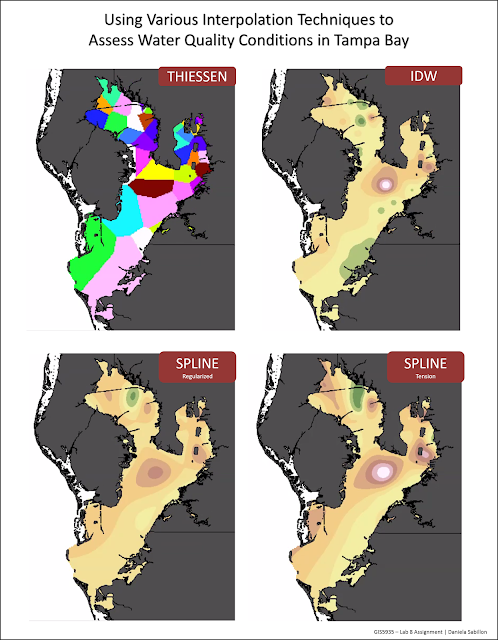Lab 8 - Surfaces: Interpolation
In this week's lesson we explored different interpolation methods and their unique properties. Some of the most popular methods include TIN, Thiessen polygons, Inverse Distance Weighted (IDW), Spline, and Kriging. The purpose of interpolation is to "predict values for cells in a raster from a limited number of sample data points", such as "elevation, rainfall, chemical concentrations, noise levels, and so on" (Esri).
Our lab assignment was broken down into two parts. For Part A, we created two DEMs, one using IDW interpolation, and the other using Spline interpolation, from provided elevation point data. After both DEMs were created, we compared them by seeing the difference in values (which was calculated using the Raster Calculator). The purpose of this exercise was to visually analyze the differences created from each of the interpolation techniques.
For Part B, we examined water quality data in Tampa Bay, Florida using four interpolation methods: Thiessen, IDW, Spline (Regulated), and Spline (Tension), as shown in the image below.
Specifically, we examined Biochemical Oxygen Demand (BOD) in milligrams per liter as the parameter to assess the water quality from various sample sites in the bay. After conducting the analysis and comparing the techniques I learned that each method has their advantages and disadvantages. For example, the Thiessen method assigns the same value as the nearest point, and creates one polygon per point in triangulated-like shapes. Although the process can be relatively easy to create, there is too much generalization that can skew statistical data. For the Spline technique, location, density, and proximity of sample data points can create a huge distortion of interpolated surfaces because the method passes exactly through all input points. This can be a disadvantage because the original sample data might require some modifications. And finally, with the IDW technique, the raster output can look too rugged, and not have a curvy-smooth appeal which can be difficult to analyze.
Personally, I would choose an interpolation technique solely based on how the sampling data was taken. I would inquire about the ultimate goal of the project's analysis, and ask how the results will be used, and for what purpose. I would also encourage samplers to stay consistent on their sampling methods and sites, as well as to adopt a strategic pattern and system.
Personally, I would choose an interpolation technique solely based on how the sampling data was taken. I would inquire about the ultimate goal of the project's analysis, and ask how the results will be used, and for what purpose. I would also encourage samplers to stay consistent on their sampling methods and sites, as well as to adopt a strategic pattern and system.

Comments
Post a Comment